
NVIDIA (NVDA) was enjoying quite a rally to start the day. All seemed right with the world. As someone recently said to me regarding another company is that it is "a victim of its own success". This is what happened to NVDA. It appears that the ceiling was reached for investors who were ready to take profits and move on. Over the prior six days of trading, NVDA was up over 19%. It was time for some profit taking.
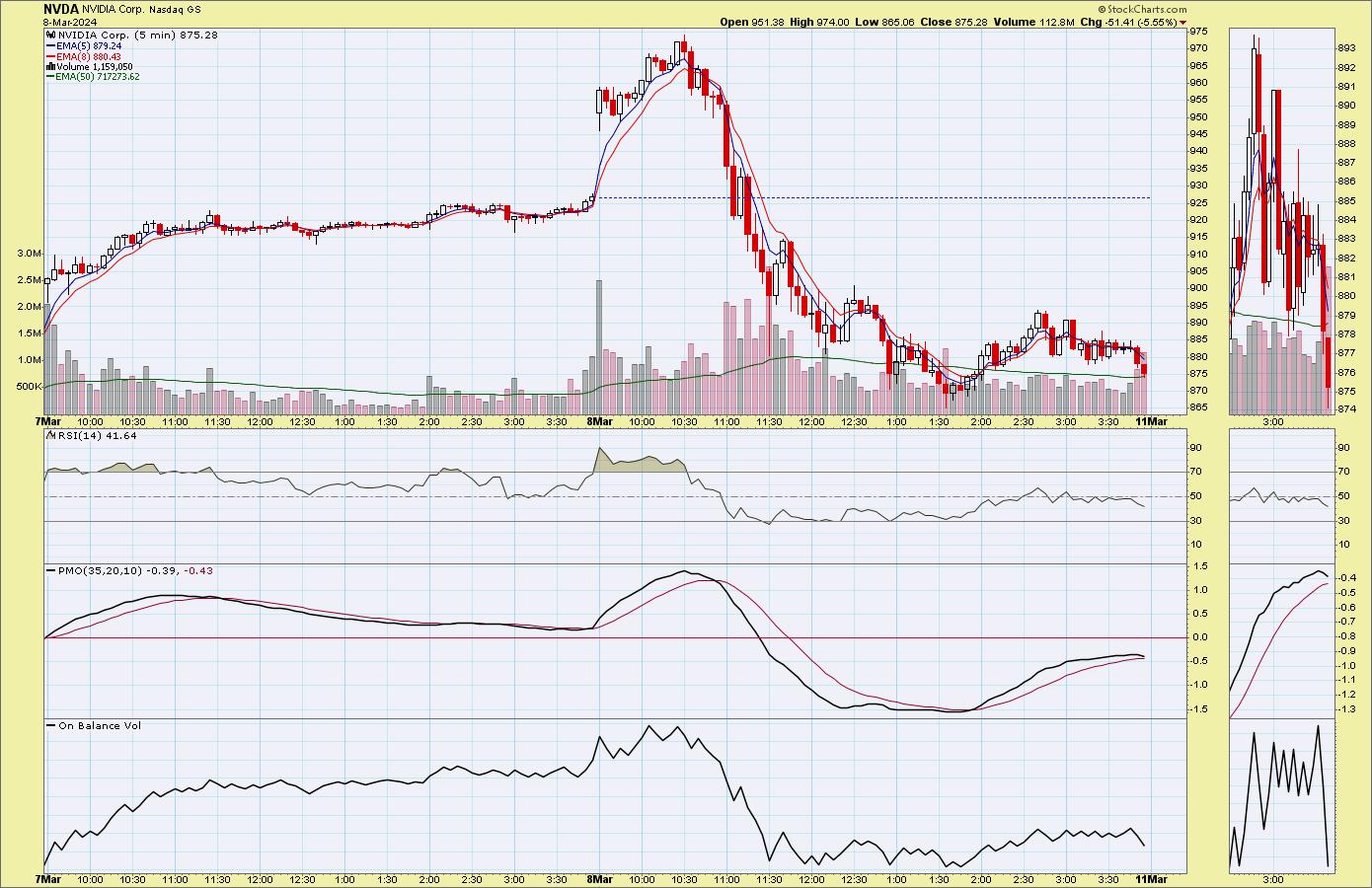
Today's decline did set up a bearish engulfing candlestick that would imply more downside ahead on Monday. Will today's decline harken more selling? We saw that decline before earnings and it didn't turn into much. It's time for a pullback or at the very least consolidation, but we wouldn't be at all surprised if this powerhouse defies gravity further. It wouldn't be a bad idea to get a stop set here to preserve profits just in case this does signal a more concerted decline.
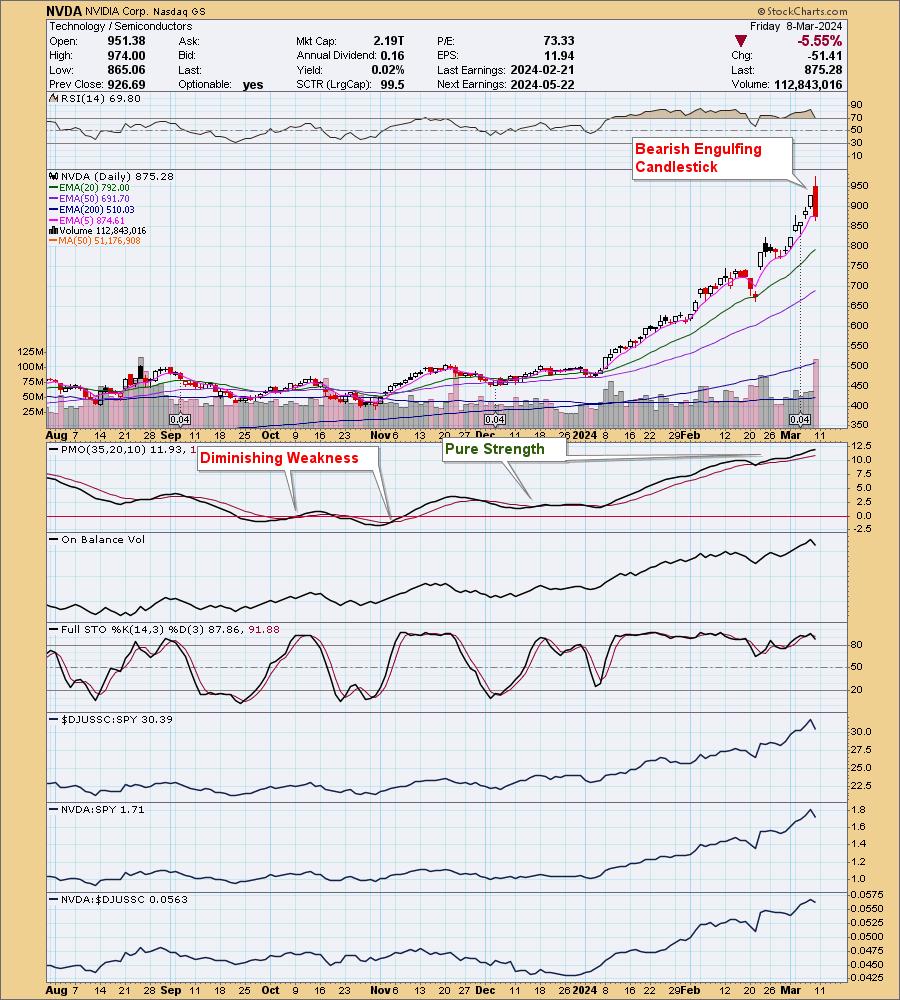
The DecisionPoint Alert Weekly Wrap presents an end-of-week assessment of the trend and condition of the Stock Market, the U.S. Dollar, Gold, Crude Oil, and Bonds. The DecisionPoint Alert daily report (Monday through Thursday) is abbreviated and gives updates on the Weekly Wrap assessments.
Watch the latest episode of DecisionPoint on our YouTube channel here!
MARKET/SPX SECTOR/INDUSTRY GROUP INDEXES
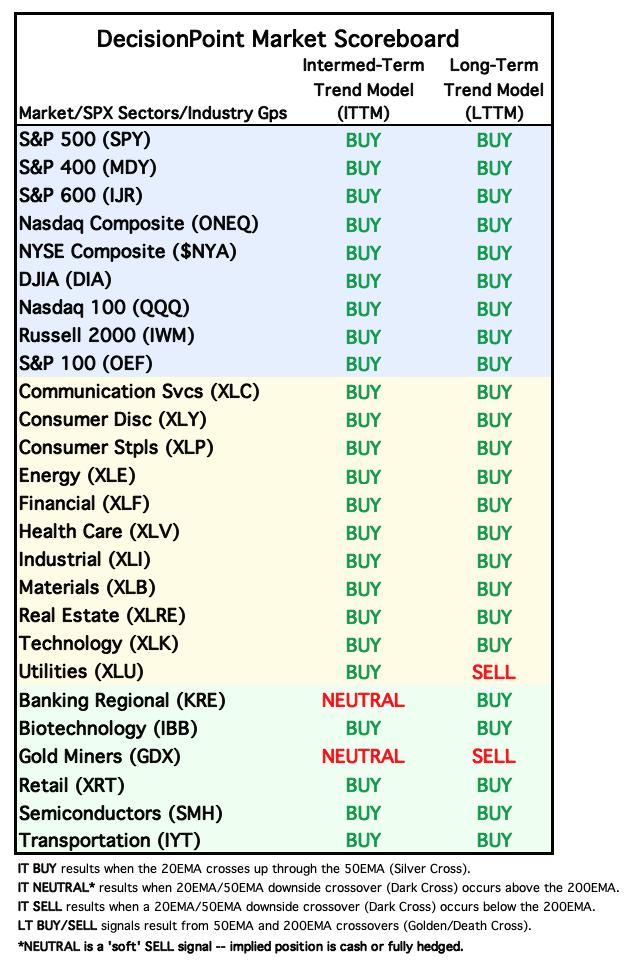
Change Today: 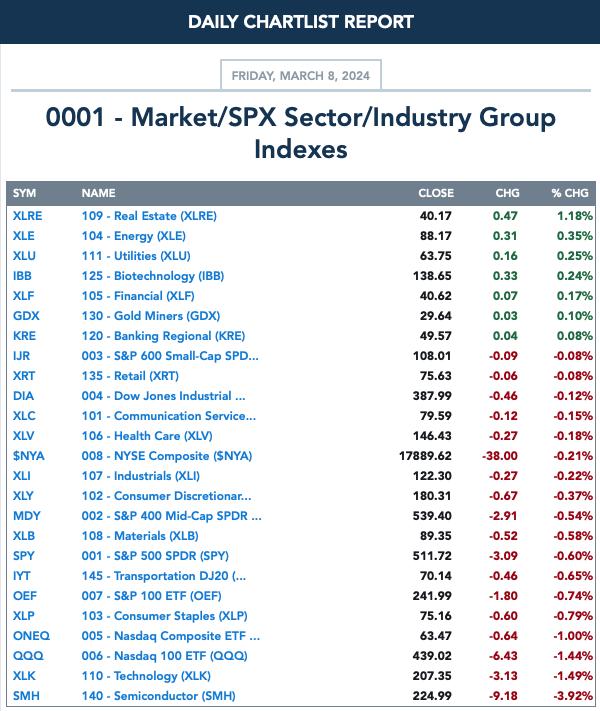
Change for the Week:
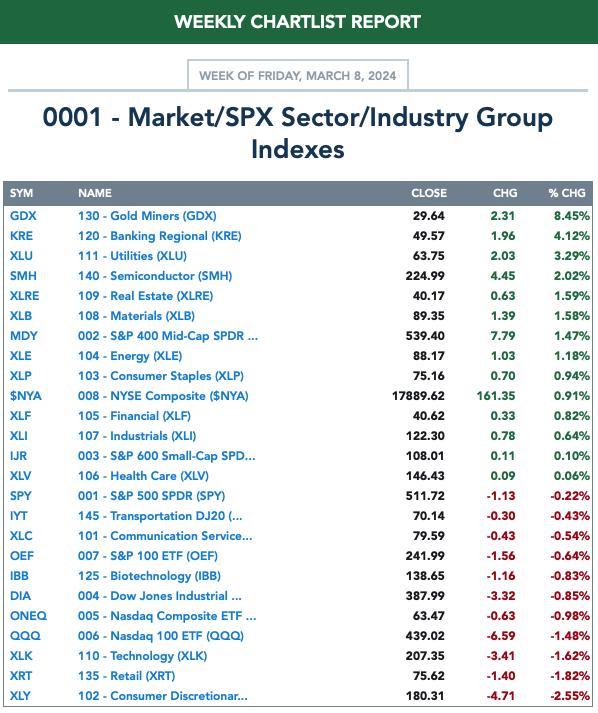
CLICK HERE for Carl's annotated Market Index, Sector, and Industry Group charts.
THE MARKET (S&P 500)
IT Trend Model: BUY as of 11/14/2023
LT Trend Model: BUY as of 3/29/2023
SPY Daily Chart: NVDA is likely the reason the market also retreated this afternoon as it made investors uneasy. This has produced a bearish engulfing candlestick that would suggest that Monday will see a decline. Will this turn into another hiccup?
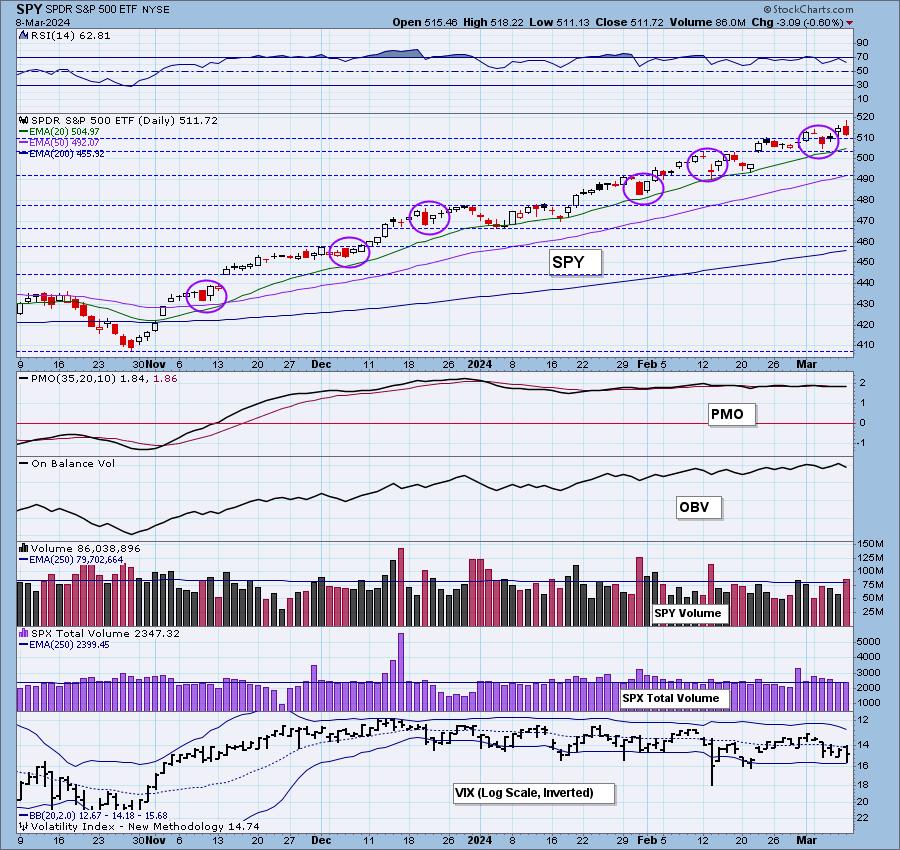
The rising wedge pattern continues to develop and puts us on the defensive somewhat. The PMO looks strong and flat well above the zero line, but it is technically on a SELL Signal which should also keep us defensive. The VIX is showing some strain as it nears the lower Bollinger Band on the inverted scale. While the PMO and wedge pattern have us defensive, we do note that Stochastics are still rising even after today's decline.
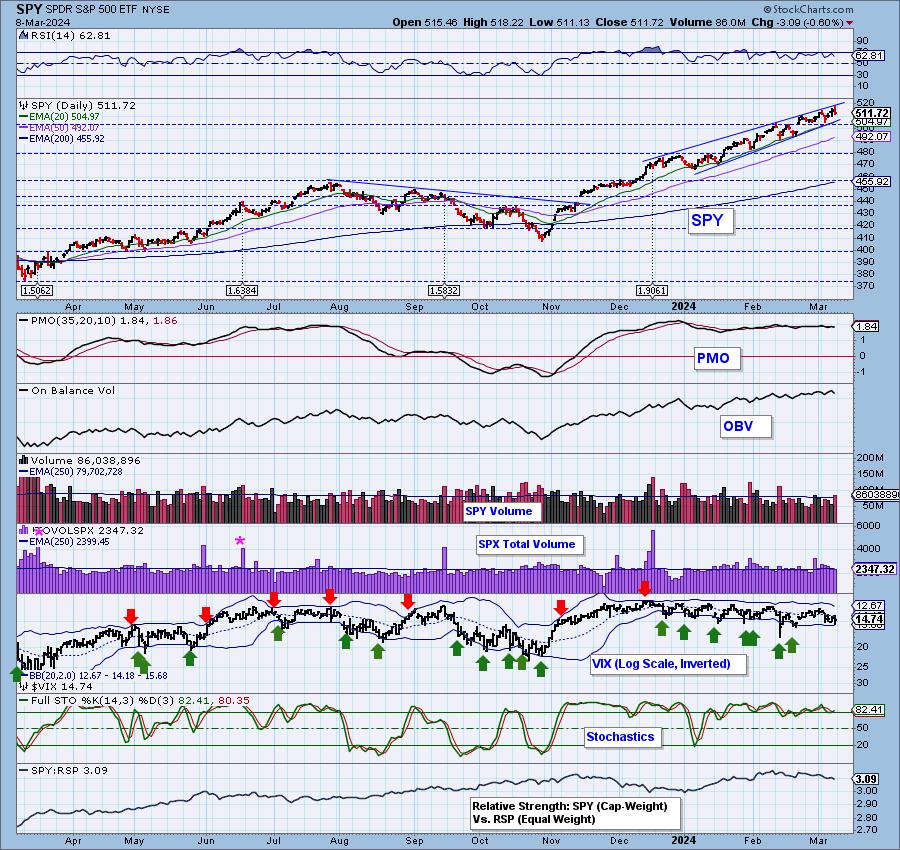
Below is the latest free DecisionPoint Trading Room recording from 3/4. You'll find these recordings posted on Mondays to our DP YouTube Channel. Be sure and subscribe HERE.
SPY Weekly Chart: Today's decline forced the SPY into a negative finish for the week. The rising trend is intact but is very steep and could be tough to maintain soon. For now, we didn't see a breakdown and new all-time highs were set this week. The weekly PMO is looking very bullish. The weekly RSI is overbought so while the daily RSI isn't overbought, this suggests big picture that prices are quite overbought.
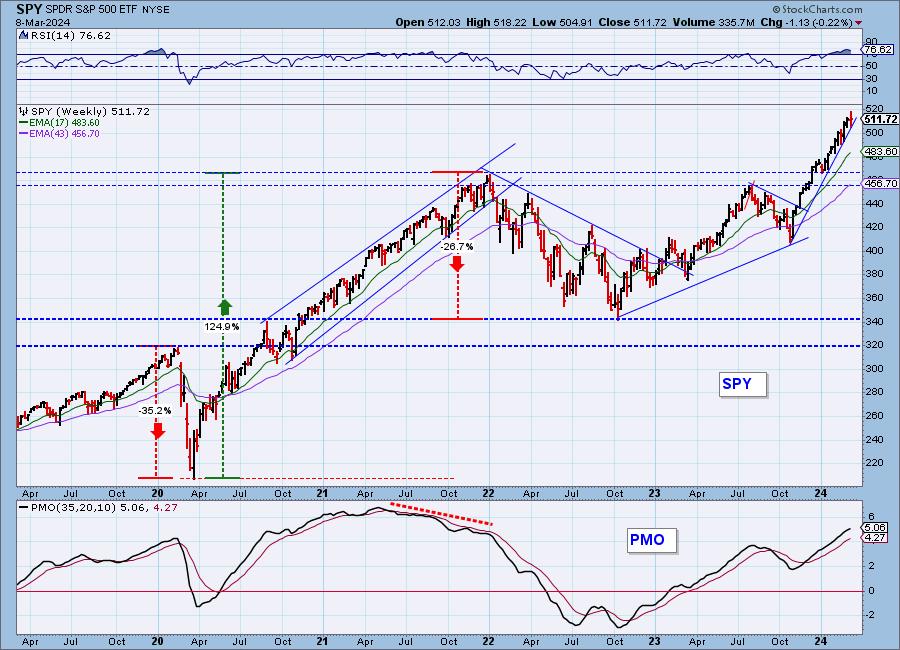
New 52-Week Highs/Lows: We spotted a new negative divergence on the New Highs/New Lows chart. Also, the 10-DMA of the High-Low Differential has topped in very overbought territory.
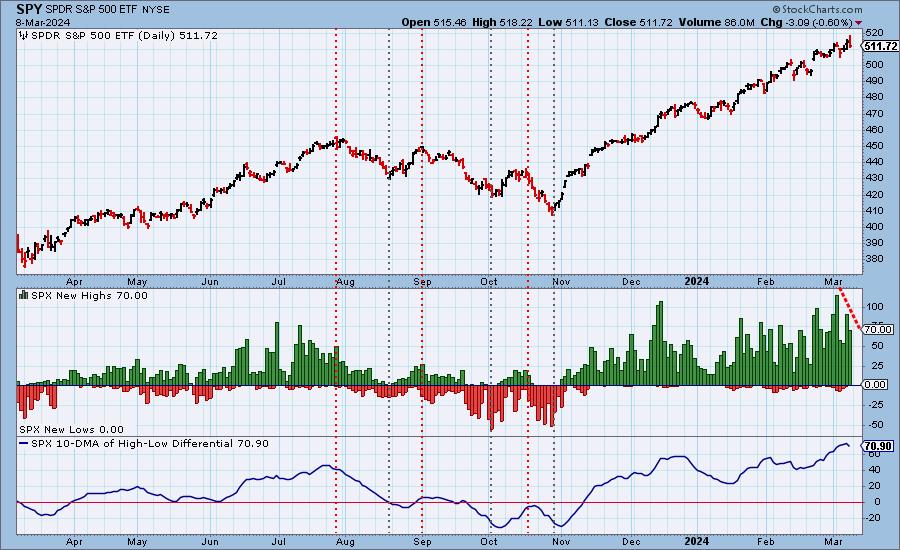
Climax Analysis: There were no climax readings today.
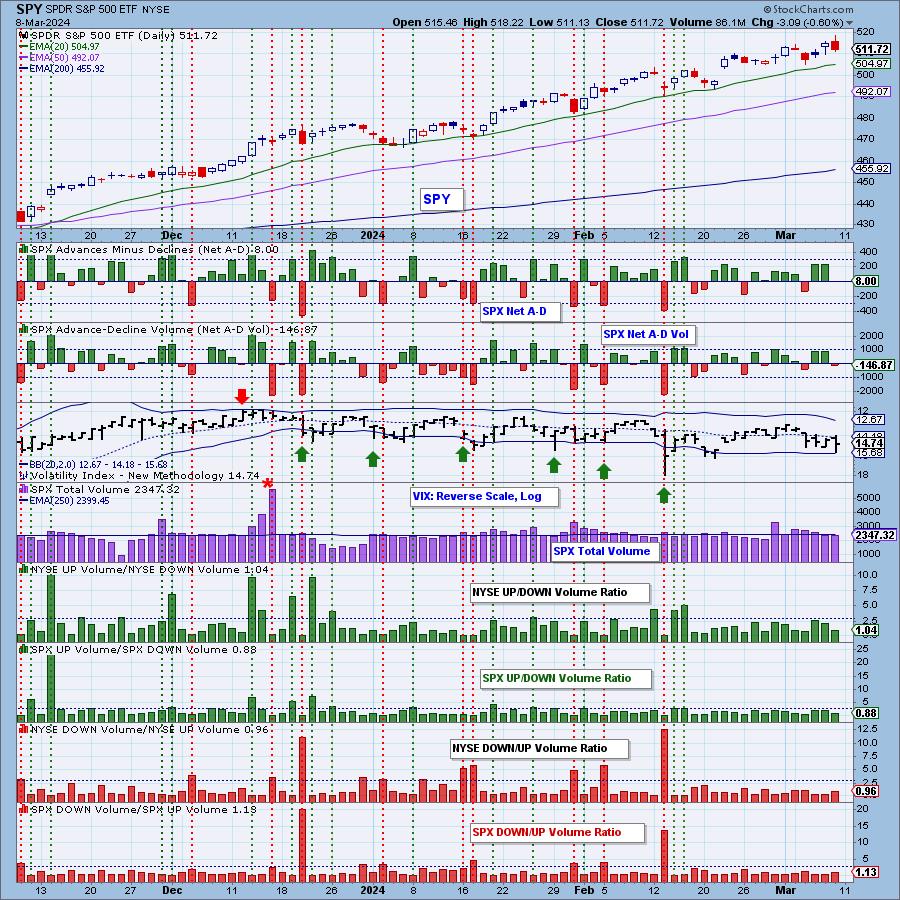
*A climax is a one-day event when market action generates very high readings in, primarily, breadth and volume indicators. We also include the VIX, watching for it to penetrate outside the Bollinger Band envelope. The vertical dotted lines mark climax days -- red for downside climaxes, and green for upside. Climaxes are at their core exhaustion events; however, at price pivots they may be initiating a change of trend.
Short-Term Market Indicators: The short-term market trend is UP and the condition is NEUTRAL.
Swenlin Trading Oscillators (STOs) are so twitchy we hate to make any sweeping conclusions about their direction these days. They did turn down today which isn't good, but as noted, they haven't been particularly enlightening. What does concern us is the negative divergences on both STOs. We saw the loss of a few rising PMOs but in general, despite the negative divergence, readings are still bullish. Negative divergences also plague our participation indicators.
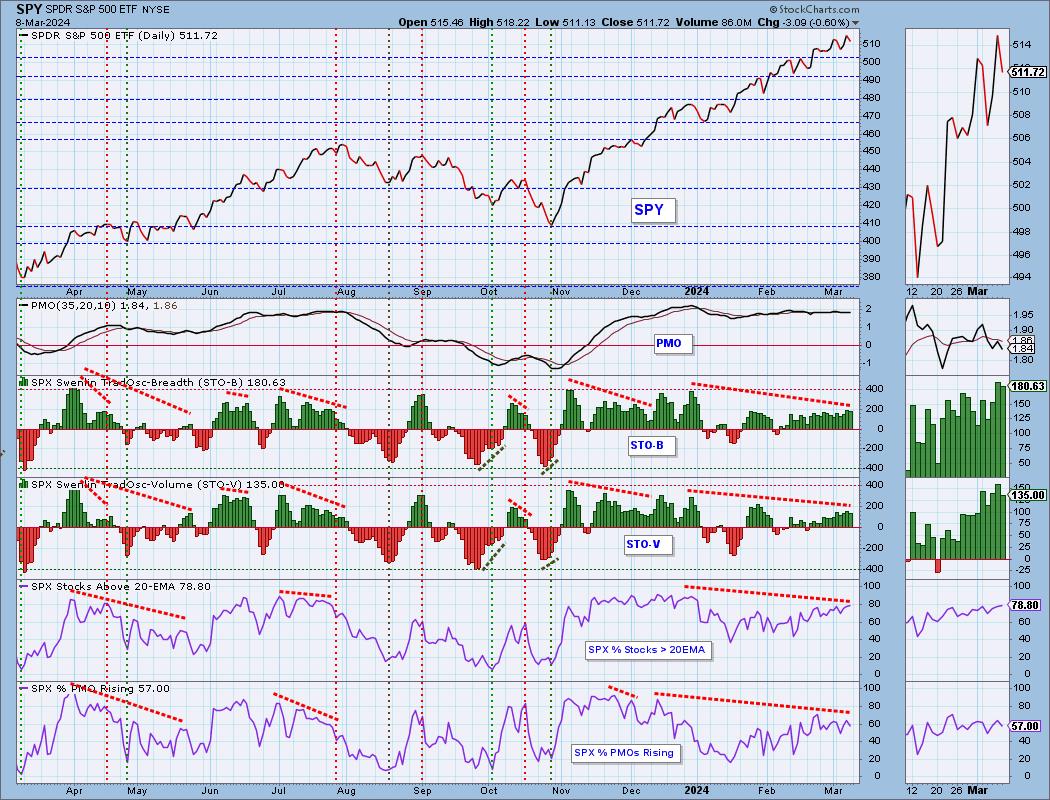
Intermediate-Term Market Indicators: The intermediate-term market trend is UP and the condition is NEUTRAL.
IT indicators are all rising, but we will note that %PMO Xover BUY Signals are vulnerable to decline now that there are only 57% of stocks holding rising PMOs. Some of those PMOs are failing and that puts Crossover BUY Signals in jeopardy. Negative divergences are still a problem. We should have far more PMO Crossover BUY Signals given the voracity of the rally since those indicators last topped.
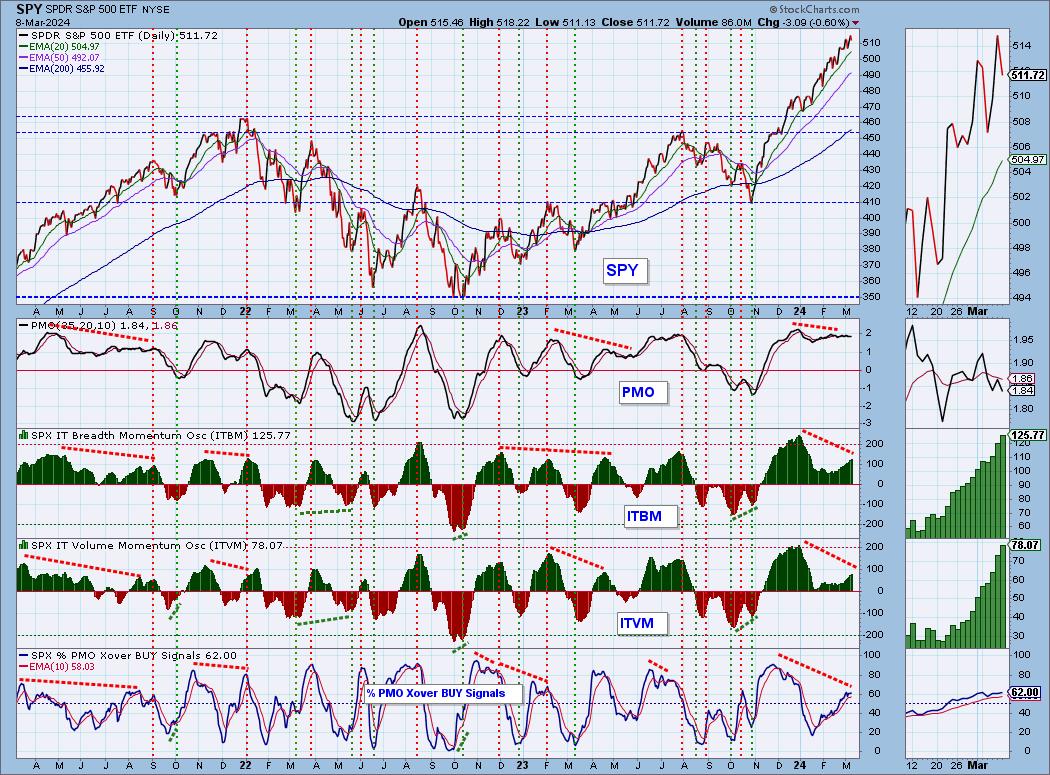
_______
PARTICIPATION: The following tables summarize participation for the major market indexes and sectors. The 1-Week Change columns inject a dynamic aspect to the presentation. There are three groups: Major Market Indexes, Miscellaneous Industry Groups, and the 11 S&P 500 Sectors.
Biotechnology (IBB) holds the highest IT Bias as the Silver Cross Index is higher than the Golden Cross Index and is seeing more expansion. It is followed closely by Energy (XLE) which saw a large increase to its SCI.
Regional Banks (KRE) hold the weakest IT Bias. The GCI is higher than the SCI as the SCI lost ground during a previous decline. It is now seeing improvement again so this negative bias will eventually ease.
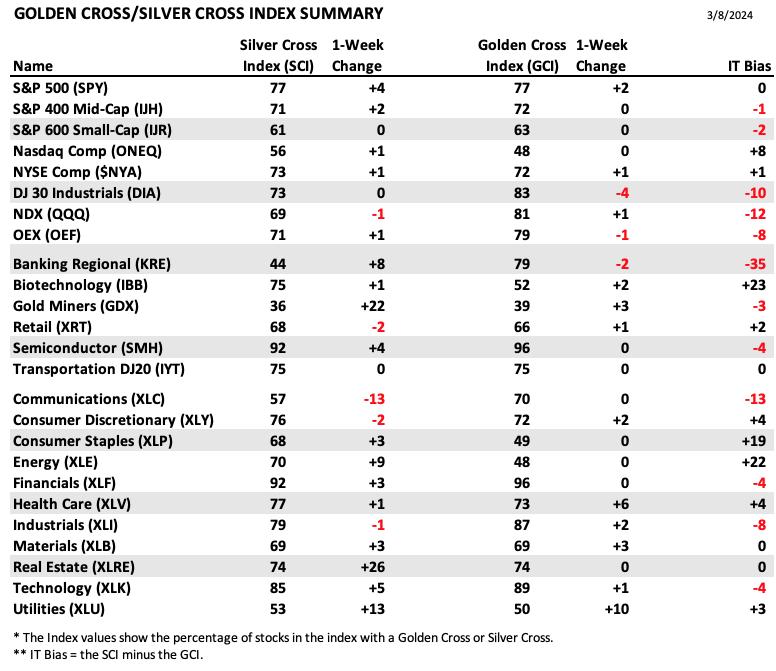
This table is sorted by SCI values. This gives a clear picture of strongest to weakest index/sector in terms of intermediate-term participation.
Real Estate (XLRE) gained the most percentage points on the SCI, closely followed by Gold Miners (GDX) which shot up on a vertical rally this week. There is a lot of improvement under the surface that make these both very interesting moving forward.
Communication Services (XLC) saw the largest decrease in the SCI. This is clearly a sector in decline and likely should be avoided near term.
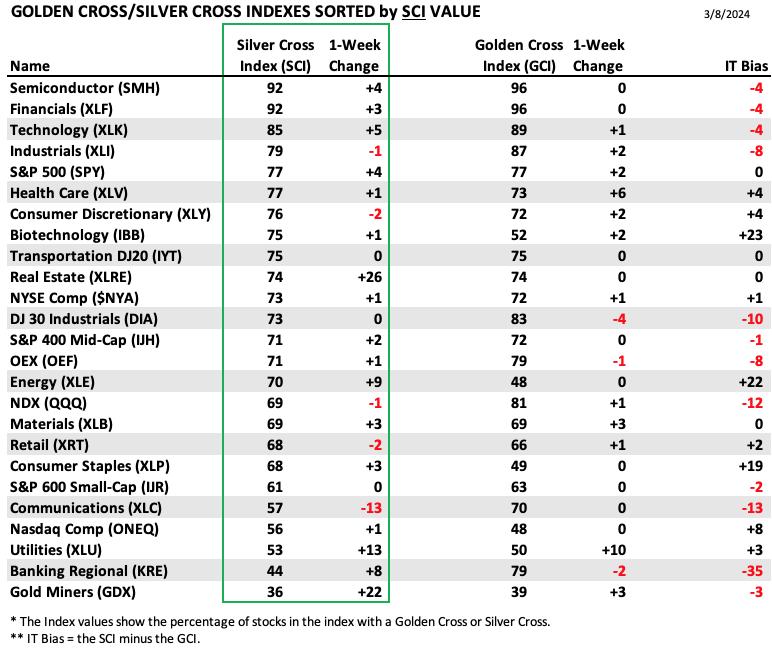
This table is sorted by GCI values. This gives a clear picture of strongest to weakest index/sector in terms of long-term participation.
Semiconductors (SMH) and Financials (XLF) hold the highest SCI and GCI values. They are still seeing improvement in the SCI so these two may not be done with their rallies. SMH does look vulnerable on its price chart.
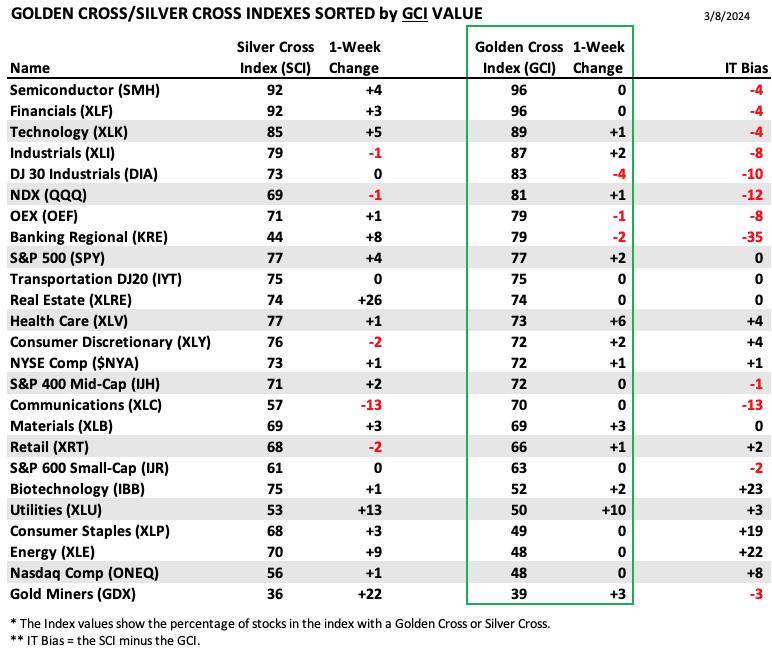
PARTICIPATION: The following chart objectively shows the depth and trend of participation in two time frames.
- Intermediate-Term - the Silver Cross Index (SCI) shows the percentage of SPX stocks on IT Trend Model BUY signals (20-EMA > 50-EMA). The opposite of the Silver Cross is a "Dark Cross" -- those stocks are, at the very least, in a correction.
- Long-Term - the Golden Cross Index (GCI) shows the percentage of SPX stocks on LT Trend Model BUY signals (50-EMA > 200-EMA). The opposite of a Golden Cross is the "Death Cross" -- those stocks are in a bear market.
The market bias is BULLISH in all three timeframes.
The short-term bias is BULLISH because we have more than 50% of stocks above their 20/50-day EMAs. This week the Silver Cross Index had a Bullish Shift across its signal line. This moved our IT Bias to BULLISH. Given we have a higher percentage of stocks above both the 20/50-day EMAs, it could continue to expand a bit further. This is a good sign of internal strength in the IT and because the SCI is above its signal line, the IT Bias is BULLISH. We do see the problem of a negative divergence on the SCI which does take the shine off this new IT Bullish Bias. The GCI is back on a rising trend and is above its signal line giving us a LT Bias of BULLISH.
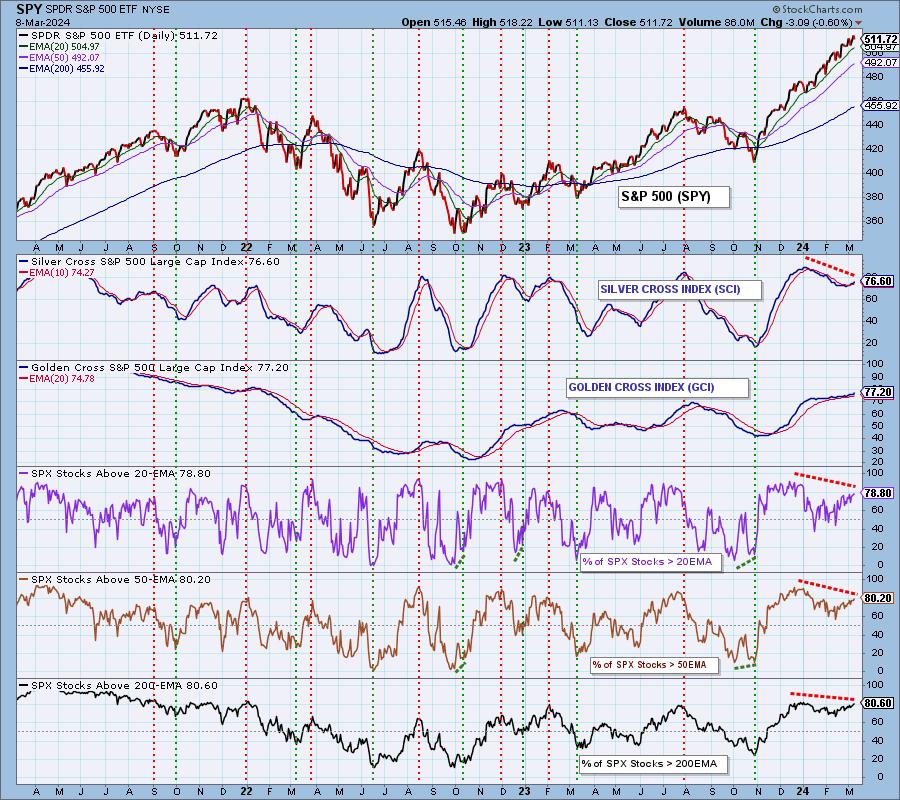
BIAS Assessment: The following table expresses the current BIAS of various price indexes based upon the relationship of the Silver Cross Index to its 10-day EMA (intermediate-term), and of the Golden Cross Index to its 20-day EMA (long-term). When the Index is above the EMA it is bullish, and it is bearish when the Index is below the EMA. The BIAS does not imply that any particular action should be taken. It is information to be used in the decision process.
The items with highlighted borders indicate that the BIAS changed today.
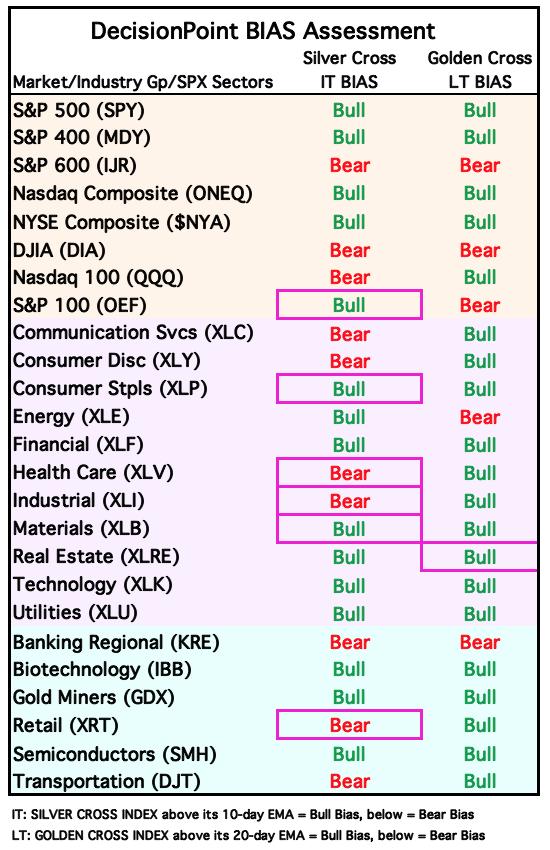
**************************************************************************************
CONCLUSION: Today's breakdown in NVDA spooked the market and had many tech stocks reversing lower. It weighed heavy on the SPY as well. This does tell us that the Magnificent 7 still hold sway. It makes us wonder whether the broader market could hold things together. We do see improvement in the Silver Cross Index that suggests they could come to the rescue, but we think more decline for NVDA would spell trouble for the market as a whole. Apple (AAPL) and Google (GOOGL) have struggled and that hasn't been a problem, but when stalwart NVDA stumbles, the market listened. STOs turned down and we saw a new negative divergence on New Highs coupled with a decline in the 10-DMA of the High-Low Differential. The market is very vulnerable and if the bearish engulfing candlestick is right, we will see more decline to begin trading next week. It may not be a good idea to expand exposure given today's downside reversal and weak indicators. Consider tightening stops as a form of profit preservation should the market continue its decline.
Erin is 60% long, 0% short.
**************************************************************************************
Have you subscribed the DecisionPoint Diamonds yet? DP does the work for you by providing handpicked stocks/ETFs from exclusive DP scans! Add it with a discount! Contact support@decisionpoint.com for more information!
BITCOIN
Bitcoin Daily Chart: Bitcoin had one day of decline this week and it really didn't do any damage to the chart. It is off to the races and we believe it will likely continue to defy gravity as speculation continues. We would be prepared for some consolidation or decline on profit taking given we have now reached all-time highs.
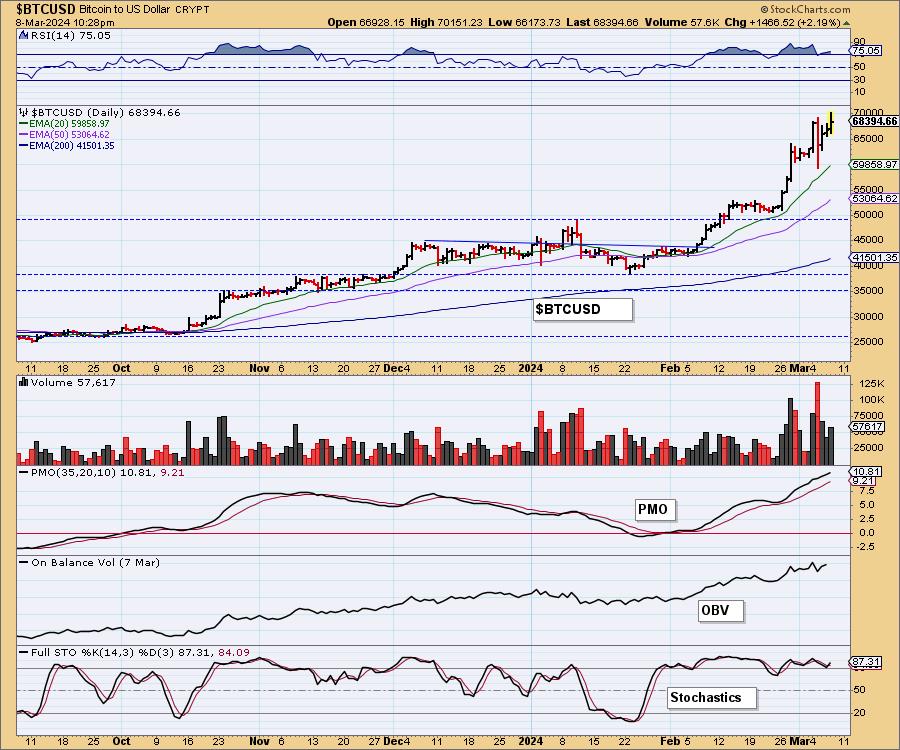
Bitcoin Weekly Chart: We can see that Bitcoin is now at all-time highs. The weekly PMO is rising strongly and is not overbought so we could certainly see more rally. We do note that this rally is parabolic so a decline could be swift and painful when it arrives. ETF holders should consider setting loose trailing stops.
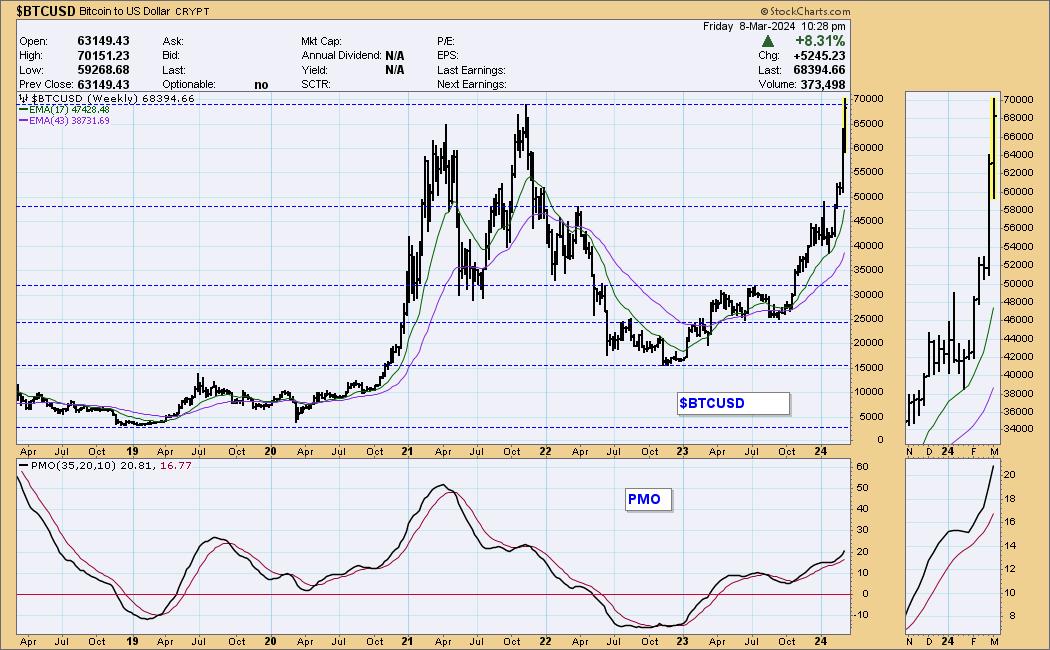
BITCOIN ETFs
Today:
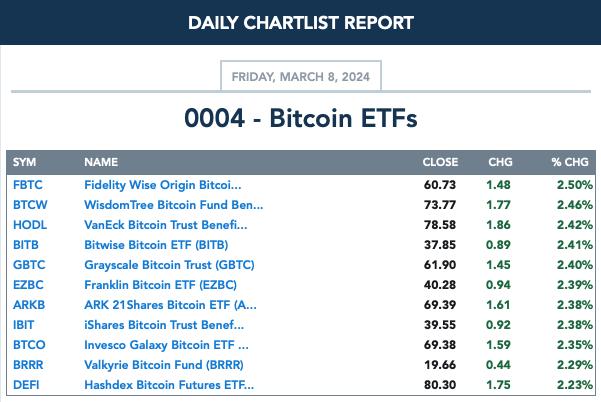
This Week:
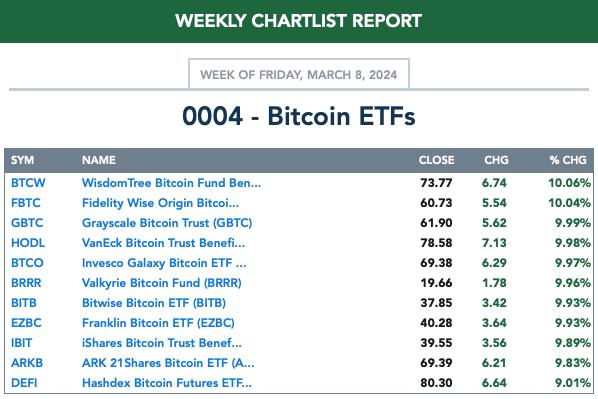
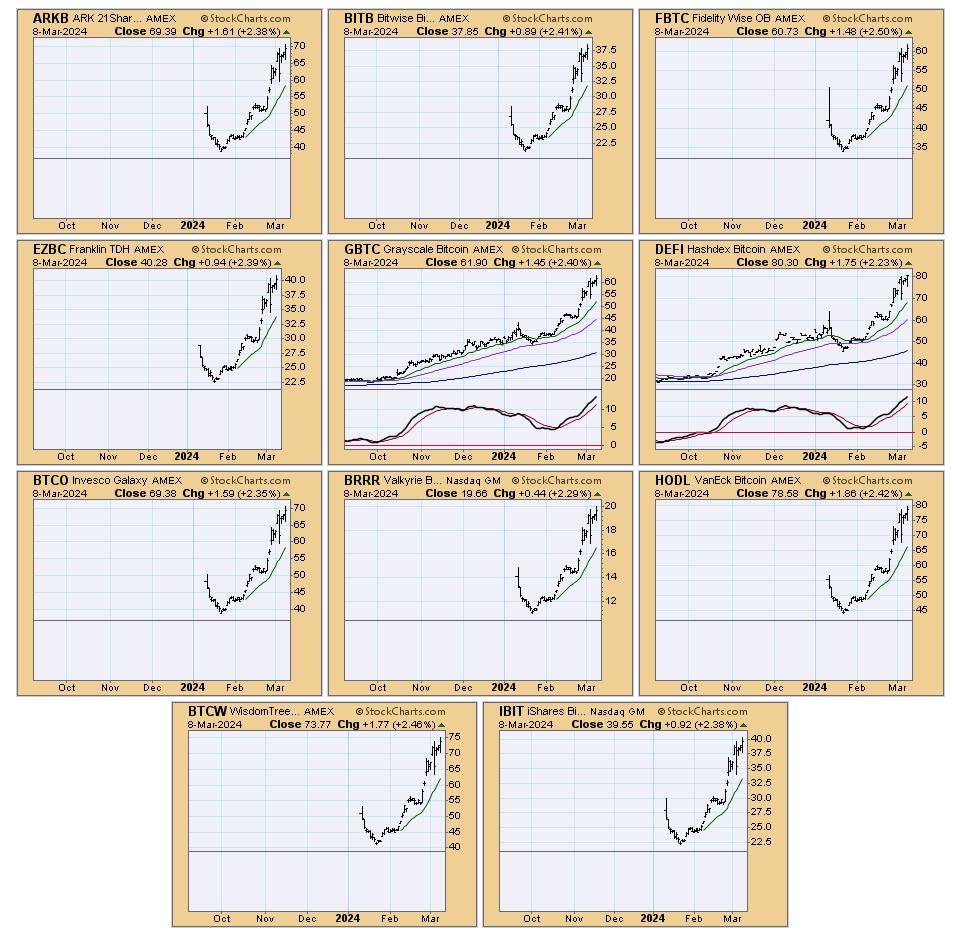
INTEREST RATES
Yields are in decline as the Fed continues its plan for rate cuts as early as June. We could see rates move down to test support at this point.
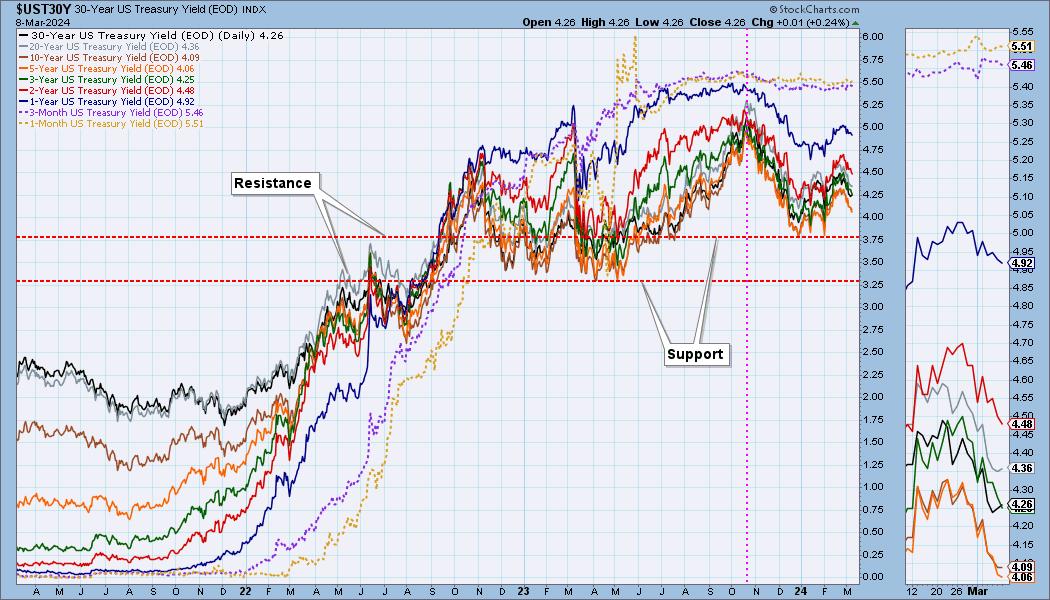
The Yield Curve Chart from StockCharts.com shows us the inversions taking place. The red line should move higher from left to right. Inversions are occurring where it moves downward.
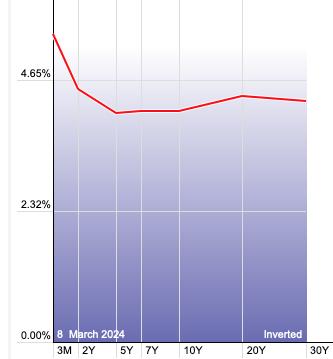
10-YEAR T-BOND YIELD
The 10-year yield is nearing a Dark Cross of the 20/50-day EMAs and it has dropped below support. It closed on support, but support is tenuous. We expect to see $TNX drop further and could even test 3.8%.
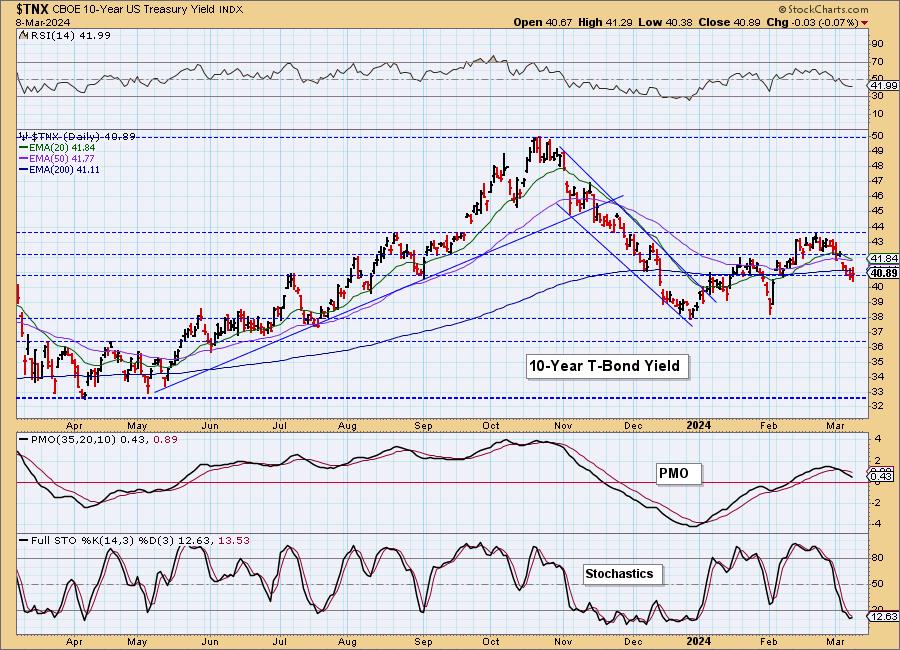
MORTGAGE INTEREST RATES (30-Yr)**
**We watch the 30-Year Fixed Mortgage Interest Rate, because, for the most part, people buy homes based upon the maximum monthly payment they can afford. As rates rise, a fixed monthly payment will carry a smaller mortgage amount, which shuts many buyers out of the market, and potential sellers will experience pressure to lower prices (to no effect so far).
--
This week the 30-Year Fixed Rate changed from 6.94 to 6.88.
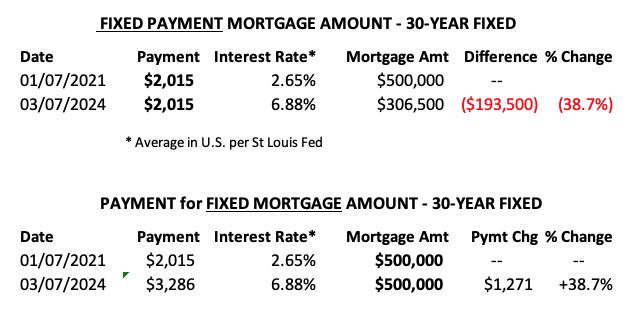
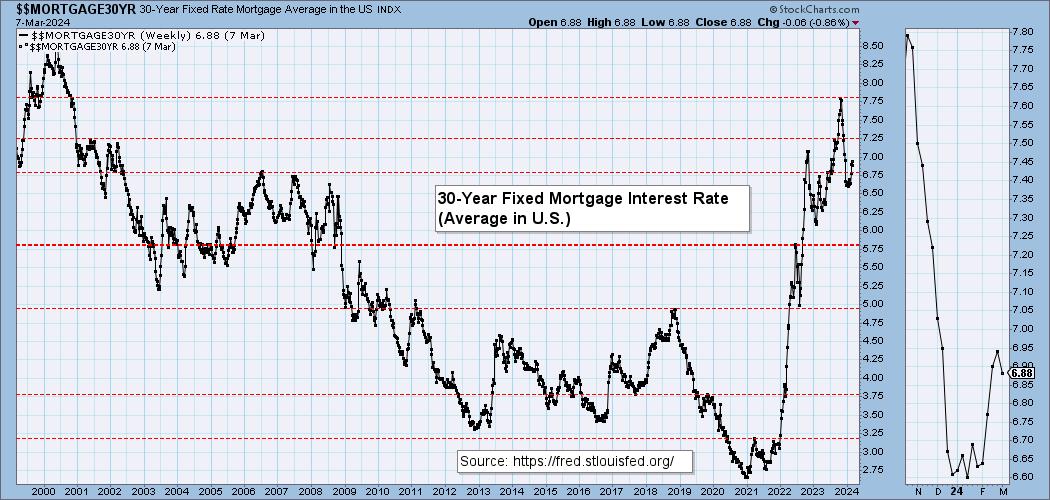
BONDS (TLT)
IT Trend Model: SELL as of 2/20/2024
LT Trend Model: SELL as of 1/19/2022
TLT Daily Chart: Bonds enjoyed a rally to start the week, but failed to overcome resistance. Yields in general look bearish so we do expect this resistance level will be broken. The RSI is positive and the PMO is still rising above the zero line with Stochastics above 80.
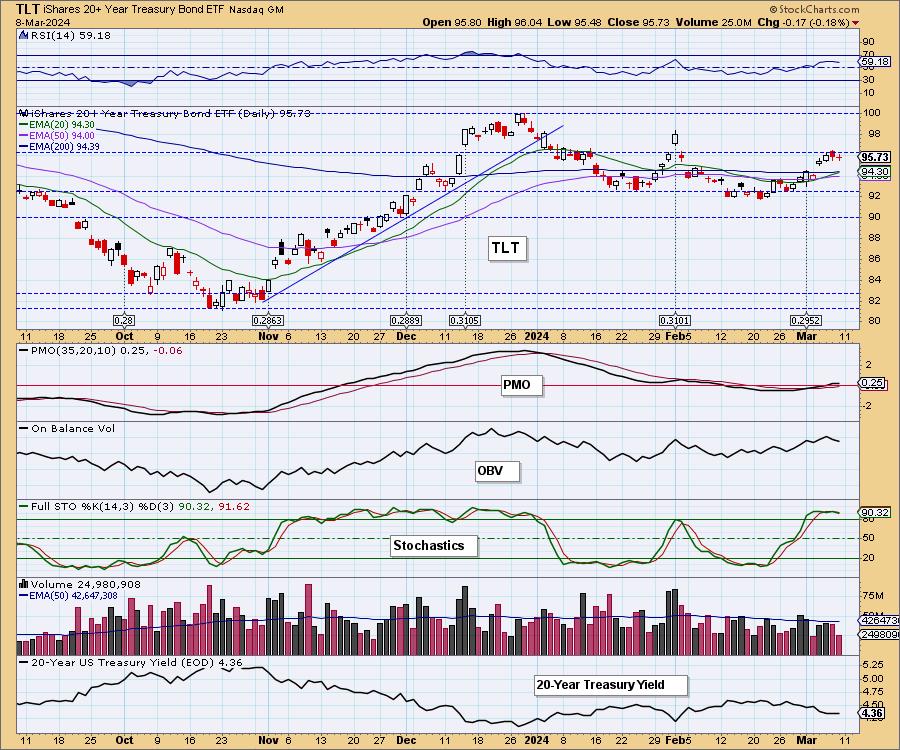
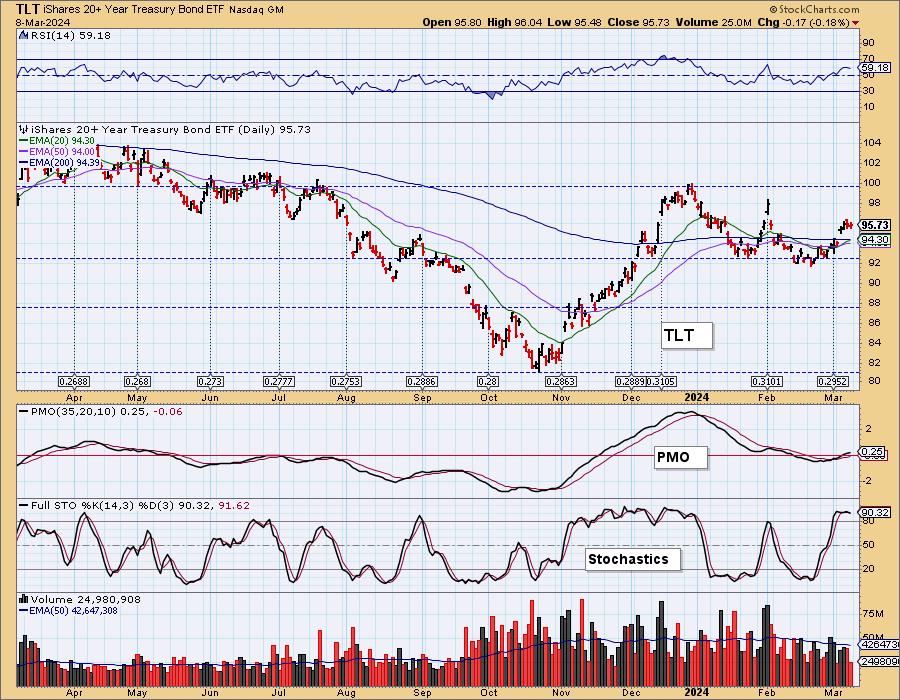
TLT Weekly Chart: The breakout didn't amount to much but now we are seeing a resurgence. The weekly PMO nearly crossed above the zero line and the weekly RSI is positive. The 20-year yield looks very toppy. The weekly chart gives TLT a clear bullish bias.
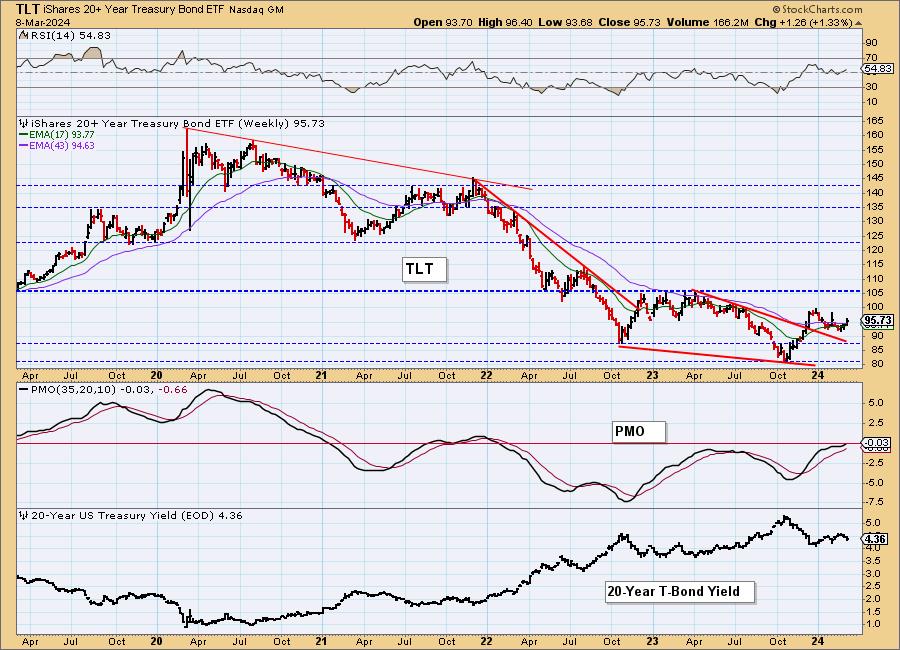
DOLLAR (UUP)
IT Trend Model: BUY as of 1/23/2024
LT Trend Model: BUY as of 5/25/2023
UUP Daily Chart: It's been a rough week for the Dollar. The Dollar did rebound today but set a much lower high and a lower low. We aren't looking for a reversal here. We expect support will need to be tested first given the bearish PMO and Stochastics.
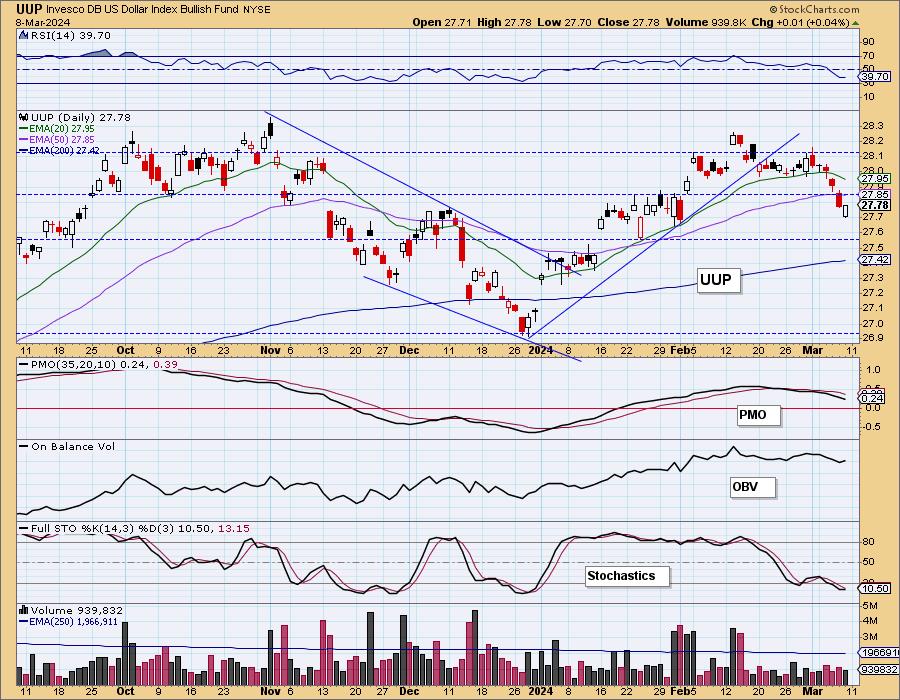

UUP Weekly Chart: The weekly PMO is triggering a Crossover SELL Signal on this week's decline. This is setting up a large double top formation that would imply a decline not only to support at 27.00. The double top should it be confirmed with a decline at 27.00, would imply a downside target that would take price all the way down to 25.50. We're not that bearish yet, but it is something we should monitor.
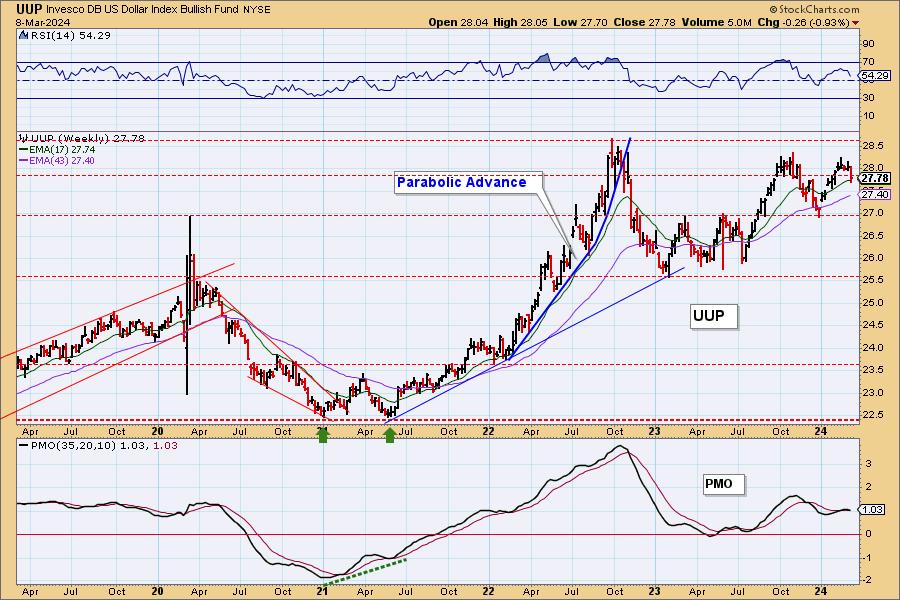
GOLD
IT Trend Model: BUY as of 10/23/2023
LT Trend Model: BUY as of 10/20/2023
GLD Daily Chart: Gold rallied strongly this week and is set up to move even higher. The one problem is that price is very overbought right now based on the RSI. This rally has run hot so we should be alert to a possible cooling period. However, with the Dollar looking so bearish, any decline would likely be mild.
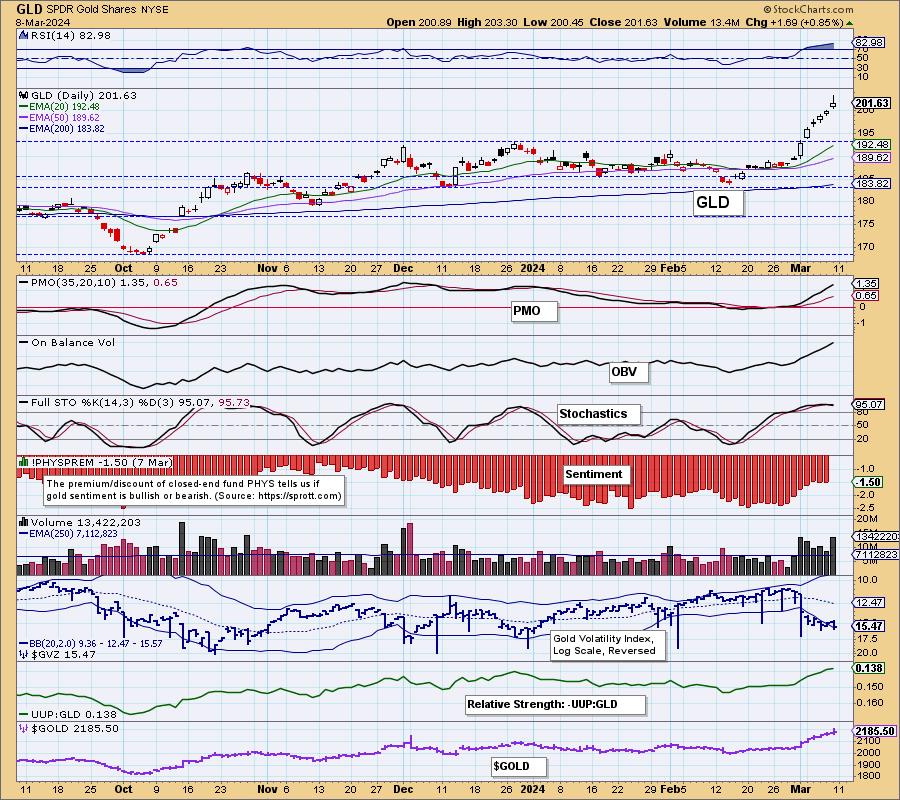
Rising relative strength against the Dollar tells us that the internals are strong for Gold right now. Notice that we did see a decline in PHYS discounts so investors have warmed to Gold, but we should be seeing them lower still given the vertical rally. That could right itself next week on a rally continuation.
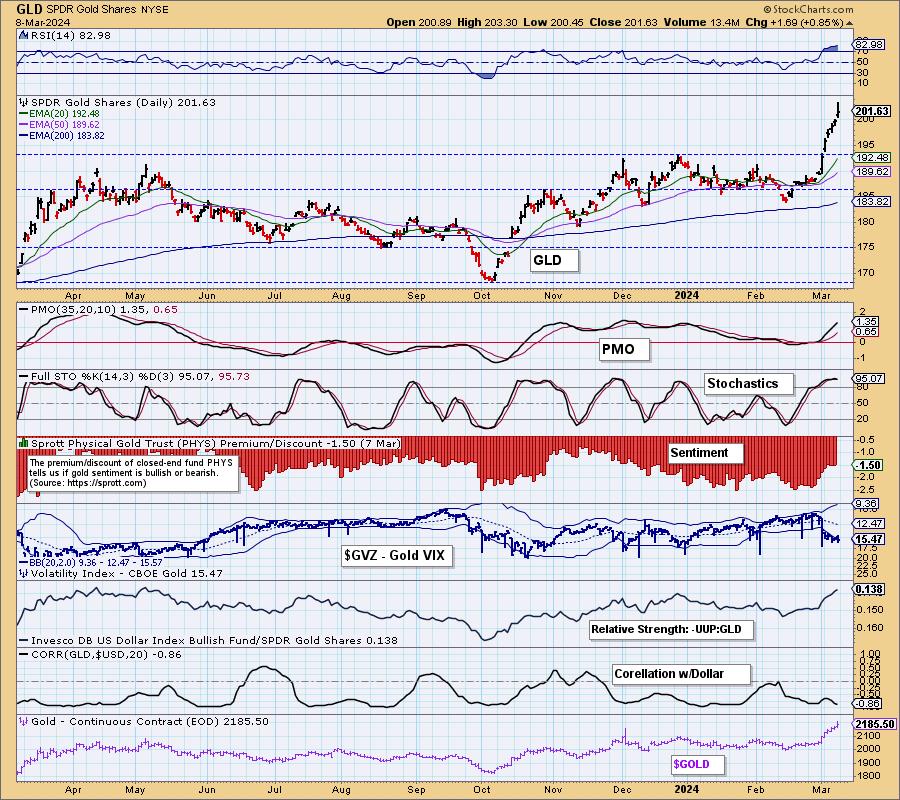
GLD Weekly Chart: We have finally set new all-time highs. Apparently fifth time is a charm as it tried five times before to overcome this level. It did so with gusto this week. The weekly PMO has turned back up and the weekly RSI is positive. The weekly RSI is getting overbought, but we've seen much higher readings during strong rallies like in 2019 and 2020.
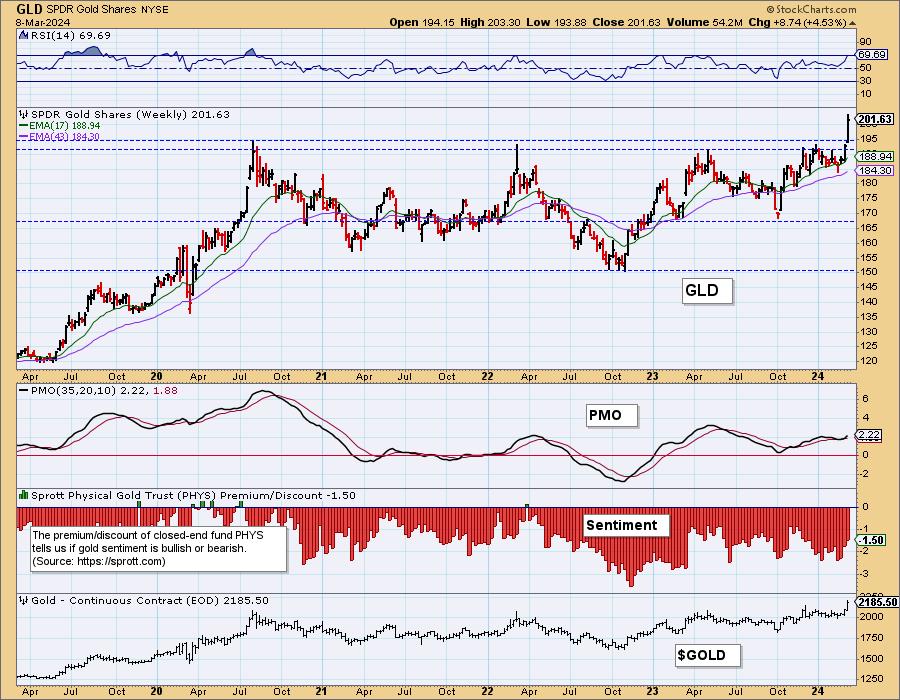
GOLD MINERS Golden and Silver Cross Indexes: Gold Miners rode Gold's coattails this week with a strong rally of their own. The double bottom was confirmed Friday of last week and it has delivered. Participation shot up and is very strong with the SCI looking particularly bullish on its strong rise. It is time to cool off. A vertical rally is difficult to sustain. A decline would make a nice entry as we see price continuing to move up toward resistance at 32.00.
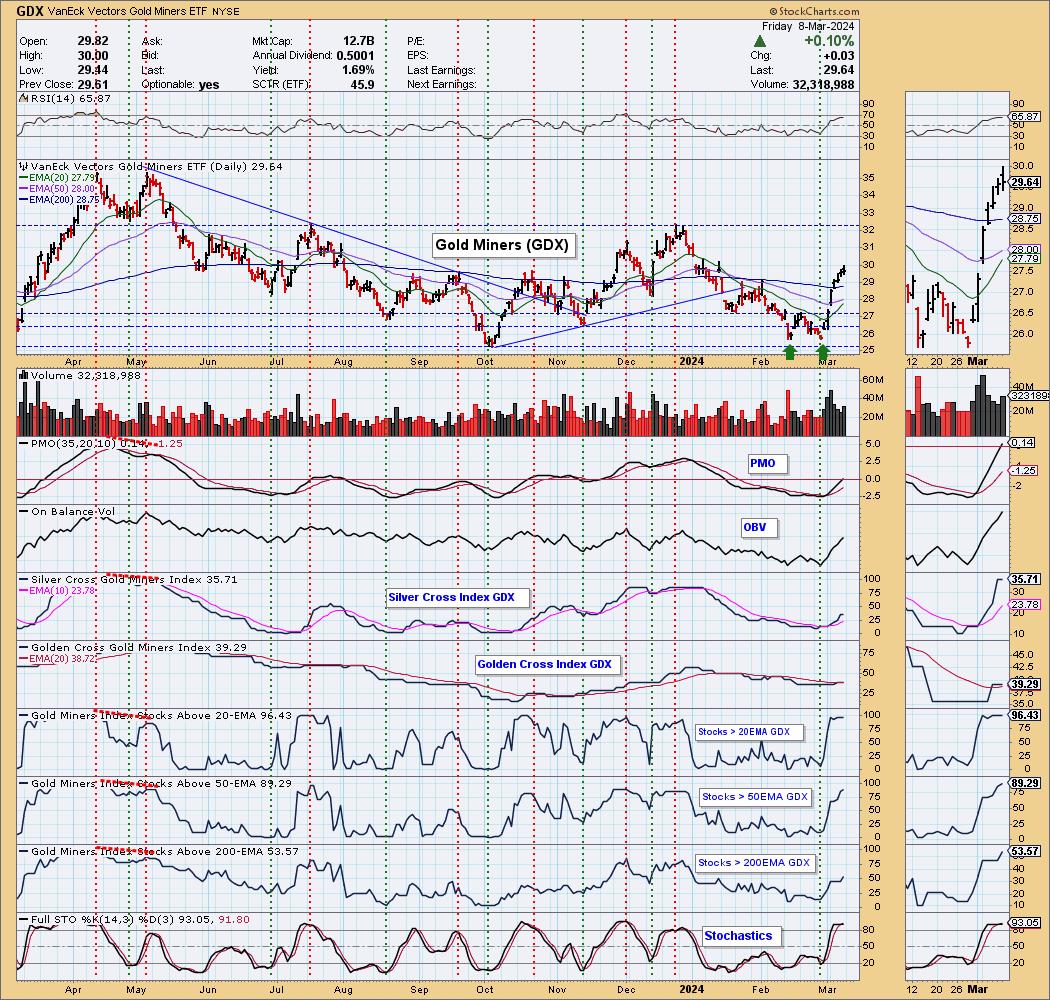
CRUDE OIL (USO)
IT Trend Model: BUY as of 2/12/2024
LT Trend Model: BUY as of 2/27/2024
USO Daily Chart: We may be getting a small handle on this saucer basing pattern. The PMO did turn down and Stochastics are flat in positive territory. However, support is still holding up for now. It will likely be slow going as Crude slogs its way sideways. If we get a downside crossover on the PMO, look for that 'handle' to get attached to this cup.
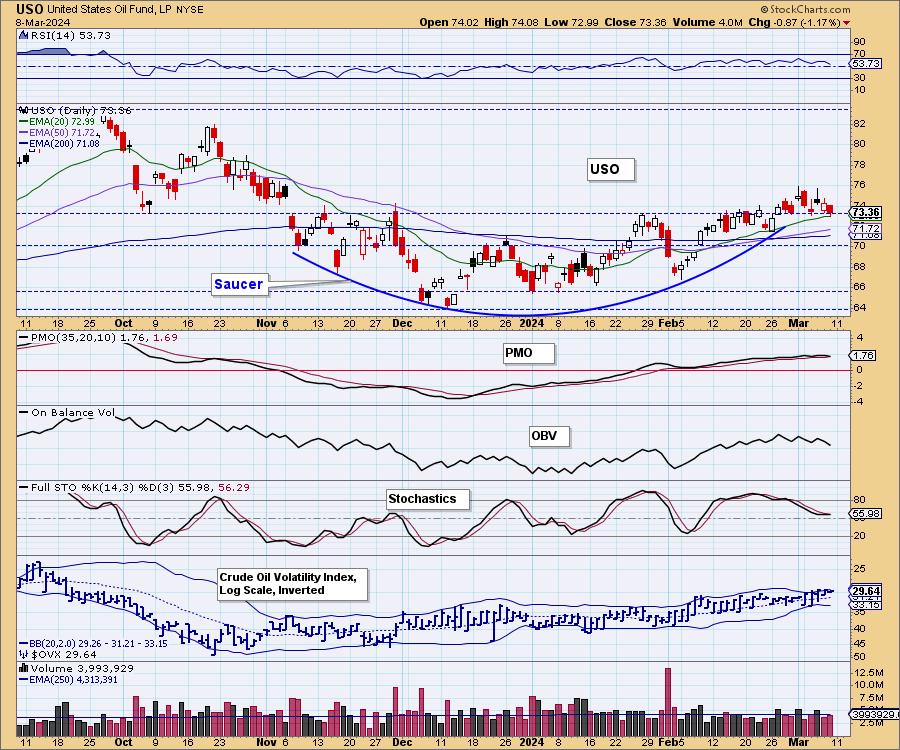
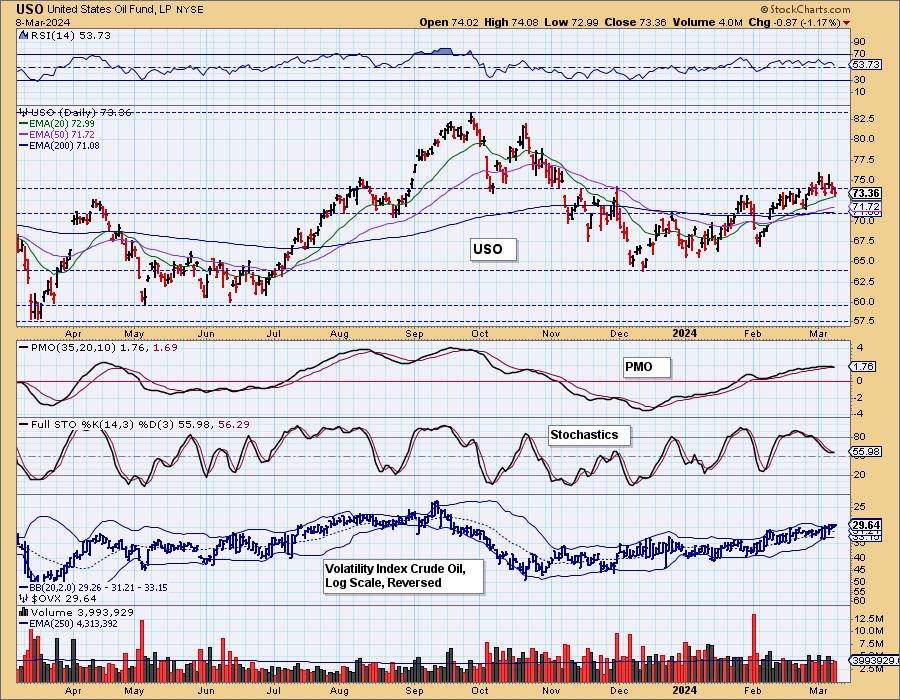
USO/$WTIC Weekly Chart: There is a symmetrical triangle on the weekly chart. These can break either way, but typically they are continuation patterns that will continue to hold the trend going into the pattern. In this case, that is up so we should expect an upside breakout. The weekly PMO is on a Crossover BUY Signal and the weekly RSI is positive. The daily chart suggests more sideways consolidation, the weekly chart puts a positive spin on it.
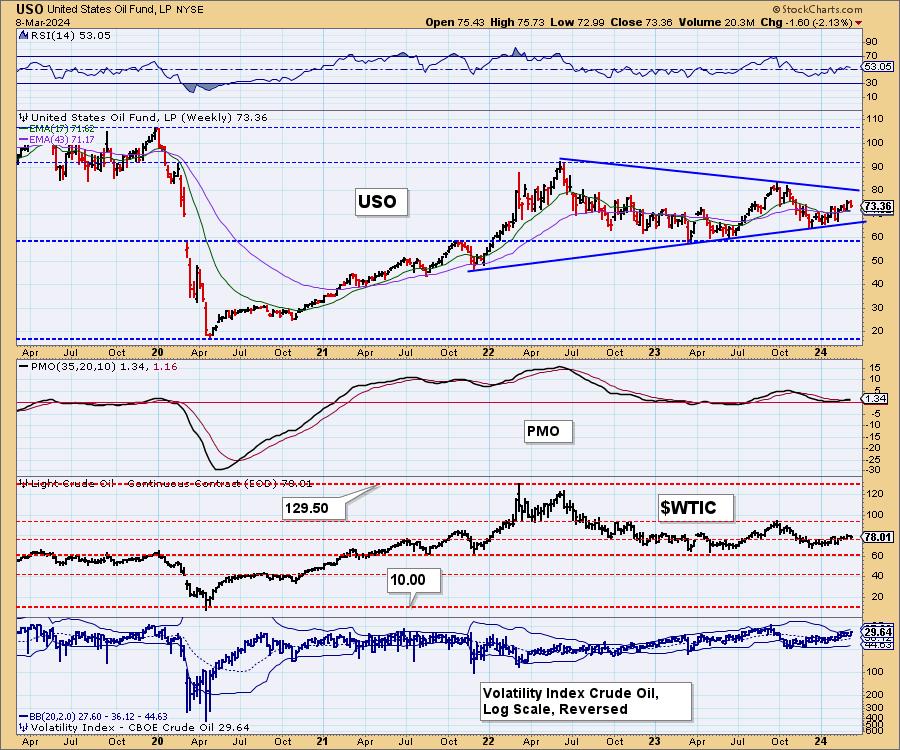
Good Luck & Good Trading!
Erin Swenlin and Carl Swenlin
Technical Analysis is a windsock, not a crystal ball. --Carl Swenlin
(c) Copyright 2024 DecisionPoint.com
Disclaimer: This blog is for educational purposes only and should not be construed as financial advice. The ideas and strategies should never be used without first assessing your own personal and financial situation, or without consulting a financial professional. Any opinions expressed herein are solely those of the author, and do not in any way represent the views or opinions of any other person or entity.
DecisionPoint is not a registered investment advisor. Investment and trading decisions are solely your responsibility. DecisionPoint newsletters, blogs or website materials should NOT be interpreted as a recommendation or solicitation to buy or sell any security or to take any specific action.
NOTE: The signal status reported herein is based upon mechanical trading model signals, specifically, the DecisionPoint Trend Model. They define the implied bias of the price index based upon moving average relationships, but they do not necessarily call for a specific action. They are information flags that should prompt chart review. Further, they do not call for continuous buying or selling during the life of the signal. For example, a BUY signal will probably (but not necessarily) return the best results if action is taken soon after the signal is generated. Additional opportunities for buying may be found as price zigzags higher, but the trader must look for optimum entry points. Conversely, exit points to preserve gains (or minimize losses) may be evident before the model mechanically closes the signal.
Helpful DecisionPoint Links:
DecisionPoint Alert Chart List
DecisionPoint Golden Cross/Silver Cross Index Chart List
DecisionPoint Sector Chart List
Price Momentum Oscillator (PMO)
